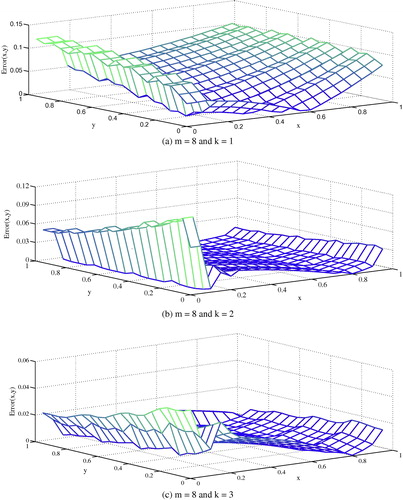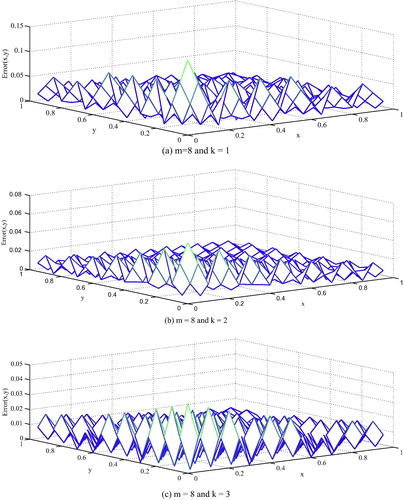Abstract
In this article a robust approach for solving mixed nonlinear Volterra–Fredholm type integral equations of the first kind is investigated. By using the modified two-dimensional block-pulse functions (M2D-BFs) and their operational matrix of integration, first kind mixed nonlinear Volterra–Fredholm type integral equations can by reduced to a nonlinear system of equations. The coefficients matrix of this system is a block matrix with lower triangular blocks. Some theorems are included to show the convergence and advantage of this method. Numerical results show that the approximate solutions have a good degree of accuracy.
1 Introduction
In this paper we applied the direct method for solving mixed nonlinear Volterra–Fredholm type integral equations of the first kind of the form:(1) where u(s,t) is an unknown function, f(x,y) and G(x,y,s,t,u(s,t)) are analytical function on [0,1) × Ω and [0,1) × Ω4, respectively, where Ω is a close subset on
. Existence and uniqueness results for Eq. Equation(1)
(1) may be found in (Diekmann, Citation1978; Pachpatte, Citation1978; Thieme, Citation1977).
Equation of type Equation(1)(1) often arise from the mathematical modeling of the spreading, in space and time, of some contagious disease in a population living in a habitat Ω (Diekmann, Citation1978; Thieme, Citation1977), in the theory of nonlinear parabolic boundary value problems (Pachpatte, Citation1978), and in many physical and biological models.
The literature on numerical methods for solving Eq. Equation(1)(1) mainly consists of projection methods, collocation methods, the trapezoidal Nyström method, Adomain decomposition method, He’s homotopy perturbation method and the two-dimensional block-pulse functions (Adomian, Citation1990, Citation1994; Adomian and Rach, Citation1992; Biazar et al., Citation2011; Brunner, Citation1990; Cardone et al., Citation2006; Cherruault et al., Citation1992; Guoqiang, Citation1995; Hacia, Citation1996; Kauthen, Citation1989; Maleknejad and Fadaei Yami, Citation2006; Maleknejad and Hadizadeh, Citation1999; Maleknejad and Mahdiani, Citation2011; Wazwaz, Citation2006; Yee, Citation1993).
Assume now that:(2) where p is a positive integer. In the present paper, we apply a modification of block-pulse functions (Maleknejad and Rahimi, Citation2011), to solve the mixed nonlinear Volterra–Fredholm type integral Eq. Equation(1)
(1) with Eq. Equation(2)
(2) .
2 M2D-BFs and their properties
Definition 1
An (m + 1)2-set of M2D-BFs consists of (m + 1)2 functions which are defined over district D = [0,1) × [0,1) as follows:(3) where
, and
(4) where m is an arbitrary positive integer, and
.
Since, each M2D-BF takes only one value in its subregion, the M2D-BFs can be expressed by the two modified one-dimensional block-pulse functions (M1D-BFs):(5) where
and
are the M1D-BFs related to variables x and y, respectively. The M2D-BFs are disjointed with each other:
(6) and are orthogonal with each other:
(7) where (x,y) ∈ D, i1,i2,j1,j2 = 0(1)m and
and
are length of intervals
and
, respectively.
2.1 Vector forms
Consider the first (m + 1)2 terms of M2D-BFs and write them concisely as (m + 1)2-vector:(8) Whence Eqs. Equation(6)
(6) and Equation(8)
(8) implies that:
(9) Now suppose that X be a (m + 1)2-vector. Hence by using Eq. Equation(9)
(9) we obtain:
(10) where
is a (m + 1)2 × (m + 1)2 diagonal matrix.
2.2 M2D-BFs expansions
A function f(x,y) defined over district L2(D) may be expanded by the M2D-BFs as:(11) where Fm,ɛ is an (m + 1)2 × 1 vector given by
(12) and Φm,ɛ(x,y) is defined in Eq. Equation(8)
(8) , and
, are obtained as:
(13) Similarly a function of four variables, k(x,y,s,t), on district L2(D × D) may be approximated with respect to M2D-BFs such as:
(14) where Φm,ɛ(x,y) and Φm,ɛ(s,t) are M2D-BFs vector of dimension (m + 1)2, and Km,ɛ is the (m + 1)2 × (m + 1)2 M2D-BFs coefficients matrix.
3 Convergence analysis
In this section, we show that the given method in the previous sections, is convergent and its order of convergence is . For our purposes we will need the following theorems.
Theorem 1
Letand
Then the following equation
(15) achieves its minimum value and also we have
(16)
Proof
It is an immediate consequence of theorem which was proved by Jiang and Schaufelberger (Citation1992).□
Theorem 2
Assume f(x,y) is continuous and is differentiable over district [−h,1 + h] × [−h,1 + h], and for i = 0(1)(k − 1), are correspondingly M2D-BFs(ɛ0) = 2D-BFs, M2D-BFs(ɛ1), …, M2D-BFs(ɛk−1) expansions of f(x, y) based on (m + 1)2 M2D-BFs over district D and
then for sufficient large m we have:
Proof
We consider and
in the district
which are approximately equal to constants n1 and n2, respectively, where m is so large. Also, we use page z = n1x + n2y + b instead of f(x,y) in the district
. Now in the district
we have:
(17) but
and EquationEq. (17)
(17) can be reformulated as:
(18) In other words:
(19) so, we have:
(20) where
.
By using Eqs. Equation(19)(19) and Equation(20)
(20) the proof is completed.□
Theorem 3
Let the representation error between f(x,y) and its two-dimensional block-pulse functions, (M2D-BFs
, over the district D, as follows:
Then
and
Proof
See (Maleknejad et al., Citation2010).□
Theorems 2 and 3 conclude that error estimation for M2D-BFs isIf we assume E1 and E2 are errors between f(x,y) and its 2D-BFs and M2D-BFs expansions, respectively, from Theorem 2 we have , and from (Maleknejad et al., Citation2010) we have
, where M is bounded of ∥Df(x,y)∥ and m shows number of 2D-BFs.
So, we have(21) where k is times of modifications of the M2D-BFs series.
Assume now that f(x,y) is approximated bywhereas,
are the approximation of
and
then for
we have
(22) We have
(23) Consequently by using Eqs. (21)–(23), the following error bound is obtained:
(24) Moreover Eq. Equation(24)
(24) implies that:
(25)
4 Method of solution
In this section, we solve mixed nonlinear Volterra–Fredholm type integral equations of the first kind of the form Eq. Equation(1)(1) with Eq. Equation(2)
(2) by using M2D-BFs.
We now approximate functions u(x,y),f(x,y),[u(x,y)]p and k(x,y,s,t) with respect to M2D-BFs by manipulation as Section 2:(26) where Φm,ɛ(x,y) is defined in Eq. Equation(8)
(8) , the vectors Um,ɛ, Fm,ɛ, Um,ɛ,p, and matrix Km,ɛ are M2D-BFs coefficients of u(x,y),f(x,y), [u(x,y)]p and k(x,y,s,t) respectively.
Lemma 1
Let (m + 1)2-vectors Um,ɛ and Um,ɛ,p be M2D-BFs coefficients of u(x,y) and [u(x,y)]p, respectively. If(27) then we have:
(28) where p ⩾ 1, is a positive integer.
Proof
(By induction) When p = 1, Eq. Equation(28)(28) follows at once from [u(x,y)]p = u(x,y). Suppose that Eq. Equation(28)
(28) holds for p, we shall deduce it for (p + 1). Since [u(x,y)]p+1 = u(x,y)[u(x,y)]p, from Eqs. Equation(26)
(26) and Equation(10)
(10) it follows that
(29) Now by using Eq. Equation(28)
(28) we obtain
(30) therefore Eq. Equation(28)
(28) holds for (p + 1), and the lemma is established.□
To approximate the integral part in Eq. Equation(1)(1) with Eq. Equation(2)
(2) , from Eq. Equation(26)
(26) we get
(31) Now by using Eqs. Equation(5)
(5) and Equation(9)
(9) , denoting Rj for the (j + 1)th row of the conventional integration operational matrix Pm,ɛ ((Pm,ɛ)(m+1)×(m+1) is operational matrix of 1D-BFs defined over [0,1), see Maleknejad and Mahdiani, Citation2011) and considering
follows:
(32) Also by using Eq. (5), Eq. (8) can be reformulated as:
(33) So, we have
(34) Also, we have:
(35) By using Eqs. (32), Equation(34)
(32) and Equation(35)
(34) , Eq. Equation(31)
(31) can be reformulated as:
(36) where
(37) where
and 0 is a zero matrix. Also
(38) where
(39)
(40) So, we have :
(41) Substituting Eqs. Equation(26)
(26) and Equation(41)
(41) into Eq. Equation(1)
(1) with Eq. Equation(2)
(2) gives:
(42) After solving the above nonlinear system by using Newton–Raphson method, we can find Um,ɛ and then
(43) Then
(44) where
is the estimation of the solution of mixed nonlinear Volterra–Fredholm type integral equation of the first kind.
5 Numerical examples
In this section to demonstrate the effectiveness of our approach several examples are presented. All results are computed by using a program written in the Matlab. The numerical experiments are carried our for the selected grid point which are proposed as (2−l; l = 1,2,3,4) and m terms and k times of modifications of the M2D-BFs series. The following problems have been tested.
Example 1
Consider the following mixed linear Volterra–Fredholm type integral equation (Maleknejad and Mahdiani, Citation2011):(45) where
(46) The exact solution is u(x,y) = e−xcos(y). and illustrate the numerical results for this example.
The error results for proposed method besides the error for method of Maleknejad and Mahdiani (Citation2011) are tabulated in .
Example 2
Consider the following mixed nonlinear Volterra–Fredholm type integral equation (Maleknejad and Mahdiani, Citation2011):(47) where
(48) The exact solution is u(x,y) = e−x−y. and illustrate the numerical results for this example.
The error results for proposed method besides the error for method of Maleknejad and Mahdiani (Citation2011) are tabulated in .
Table 1 Numerical results of Example 1 with M2D-BFs.
Table 2 Error results for Example 1.
Table 3 Numerical results of Example 2 with M2D-BFs.
Table 4 Error results for Example 2.
6 Conclusion
In this paper a computational method for approximate solution of mixed nonlinear Volterra–Fredholm type integral equations of the first kind, based on the expansion of the solution as series of M2D-BFs was presented. This method converts a mixed nonlinear Volterra–Fredholm type integral equation whose answer is the coefficients of M2D-BFs expansion of the solution of mixed nonlinear Volterra–Fredholm type integral equation. Also, we have shown that our approach is convergent and its order of convergence is . This method can be easily extended and applied to mixed nonlinear Volterra–Fredholm type integral equations of the second kind and nonlinear system of the mixed Volterra–Fredholm type integral equations.
References
- G.AdomianA review of the decomposition method and some recent results for nonlinear equationMathematical and Computer Modelling13719901743
- G.AdomianSolving Frontire Problems of Physics-the Decomposition Method1994KluwerDordrecht
- G.AdomianR.RachNoise terms in decomposition series solutionComputer and Mathematics with Applications241119926164
- J.BiazarB.GhanbariM.Gholami PorshokouhiM.Gholami PorshokouhiHe’s homotopy perturbation method: a strongly promising method for solving non-linear systems of the mixed Volterra–Fredholm integral equationsComputer and Mathematics with Applications61201110161023
- H.BrunnerOn the numerical solution of nonlinear Volterra–Fredholm integral equation by collocation methodsSIAM Journal on Numerical Analysis27419909781000
- A.CardoneE.MessinaE.RussoA fast iterative method for discretized Volterra–Fredholm integral equationsJournal of Computational and Applied Mathematics1892006568579
- Y.CherruaultG.SaccomandiB.SomeNew results for convergence of Adomian’s method applied to integral equationsMathematical and Computer Modelling162199285
- O.DiekmannThresholds and travelling waves for the geographical spread of infectionJournal Mathematical Biology61978109130
- H.GuoqiangAsymptotic error expansion for the Nystrom method for a nonlinear Volterra–Fredholm integral equationsComputer and Mathematics with Applications5919954959
- L.HaciaOn approximate solution for integral equations of mixed typeZeitschrift für Angewandte Mathematik761996415416
- Z.H.JiangW.SchaufelbergerBlock Pulse functions and their applications in control systems1992Spriger-VerlagBerlin
- P.G.KauthenContinuous time collocation methods for Volterra–Fredholm integral equationsNumerische Mathematik561989409424
- K.MaleknejadM.R.Fadaei YamiA computational method for system of Volterra–Fredholm integral equationsApplied Mathematics and Computation1832006589595
- K.MaleknejadM.HadizadehA new computational method for Volterra–Fredholm integral equationsComputer and Mathematics with Applications37199918
- K.MaleknejadK.MahdianiSolving nonlinear mixed Volterra–Fredholm integral equations with two dimensional block-pulse functions using direct methodCommunications in Nonlinear Science and Numerical Simulation16201135123519
- K.MaleknejadB.RahimiModification of block pulse functions and their application to solve numerically Volterra integral equation of the first kindCommunications in Nonlinear Science and Numerical Simulation16201124692477
- K.MaleknejadS.SohrabiB.BaranjiApplication of 2D-BPFs to nonlinear integral equationsCommunications in Nonlinear Science and Numerical Simulation152010527535
- B.G.PachpatteOn mixed Volterra–Fredholm type integral equationsIndian Journal of Pure and Applied Mathematics171978488496
- H.R.ThiemeA model for spatial spread of an epidemicJournal of Mathematical Biology41977337351
- A.M.WazwazA reliable treatment for mix Volterra–Fredholm integral equationsApplied Mathematics and Computation1892006405414
- E.YeeApplication of the decomposition method to the solve of the reaction–convection–diffusion equationApplied Mathematics and Computation561993114

